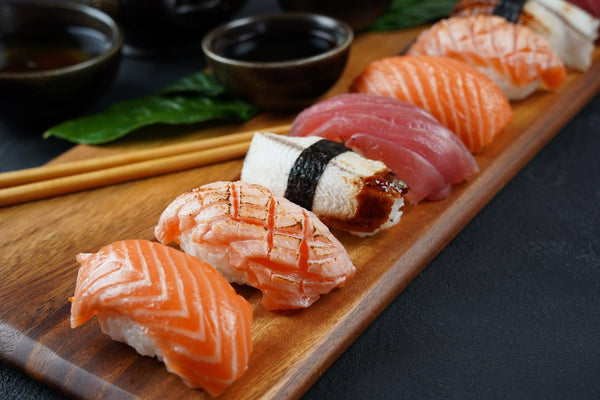
Jump to:
Japanese sushi goes far beyond what you'll find at restaurants outside Japan.
Every region, city and local neighborhood in Japan has its own favorite sushi spots, from exclusive sushi “bars” to casual standbys, each offering seasonal specialties and local favorites you won't find anywhere else.
Let's look at what Japanese locals actually order, where they go for different sushi experiences and how you can make the most of your sushi adventures in Japan.
What Japanese Locals Really Order at Sushi Restaurants
The True Local Favorites
Japanese sushi preferences often surprise international visitors.
While salmon dominates overseas markets, Japanese diners gravitate toward a more diverse array of seafood options that showcase the country's incredible maritime bounty. Understanding these preferences offers insight into Japanese culinary culture and helps visitors appreciate why certain pieces command such respect.
At the pinnacle of Japanese sushi sits chutoro and otoro, the medium-fatty and fatty cuts of bluefin tuna. These prized pieces come from specific parts of the fish where fat accumulates, creating an almost buttery texture that melts in your mouth. The marbling pattern resembles that of premium wagyu beef, and the deep, complex flavor develops slowly as the fish warms slightly on your tongue. Many sushi connoisseurs consider these cuts the ultimate expression of the chef's skill in aging and preparing fish.

Uni (sea urchin) represents another highly sought-after delicacy, particularly specimens from Hokkaido's cold waters. Premium uni should taste sweet and creamy with subtle oceanic notes, never fishy or bitter. The best uni arrives in perfect golden-orange segments, each one carefully placed on perfectly seasoned rice. Peak season runs from late spring through summer, when the uni develops its richest flavor and most luxurious texture.

Kohada (gizzard shad) might seem humble compared to fatty tuna or uni, but this silver-skinned fish serves as a benchmark for judging a sushi restaurant's quality. The preparation requires precise aging and curing to transform the naturally oily fish into a perfectly balanced piece of sushi. Sushi masters spend years perfecting their kohada technique, adjusting the vinegar cure based on the fish's size, season and fat content.
Following the Seasons of Sushi & Sashimi in Japan
Seasonal awareness deeply influences Japanese sushi culture – much as it has a profound effect on eating in general in Japan.
Spring brings the arrival of sayori (halfbeak), a delicate fish traditionally presented in a dramatic curl that showcases its silver-and-blue coloring. The mild, clean flavor perfectly captures the transition from winter to spring. As temperatures rise, shinko (baby gizzard shad) appears on menus, offering a lighter, more delicate version of its mature counterpart.

Summer ushers in a variety of light, refreshing options. Young bonito arrives fresh from southern waters, often lightly seared to enhance its clean, meaty flavor. Local fishermen deliver fresh aji (horse mackerel) daily, which skilled chefs quickly prepare to preserve its delicate taste. The warmer months also see an increase in silver-skinned fish varieties, each requiring specific aging and preparation methods.

Autumn marks a significant shift in sushi offerings as fish begin storing fat for winter. Sanma (pacific saury) arrives in peak condition, its tender flesh perfectly suited for nigiri or pressed sushi. This season also brings out the best in mackerel varieties, with many chefs preparing special cured versions that highlight the fish's increased fat content.

Winter shows why Japanese food culture places such emphasis on seasonality. Cold waters produce yellowtail and tuna with extraordinarily high fat content, creating pieces with unparalleled richness and flavor. Many sushi enthusiasts save their most expensive sushi meals for winter, when these prized fish reach their peak condition.
Got hungry for sushi with all this talk of seasonal delicacies in Japan? Try making some sushi at home featuring our recommendations on wasabi, ponzu, aged soy sauce and much more.
Popular Choices at Conveyor Belt Sushi
Conveyor belt sushi restaurants democratized sushi in Japan, making this once-exclusive cuisine accessible to everyone.
While some traditionalists initially resisted the concept, kaitenzushi has evolved into its own legitimate sushi category, complete with unique specialties and traditions.
Modern kaitenzushi chains have sophisticated ordering systems that ensure quality and freshness. Many pieces arrive made-to-order rather than circulating on the belt. Standard plates typically feature maguro (regular tuna), which offers clean, straightforward flavor perfect for everyday eating. Each cut comes from a specific part of the tuna, with subtle variations in taste and texture that regular customers learn to distinguish.
Everyday Favorites

Regular tuna (maguro) remains popular at conveyor belt spots, offering clean flavor at reasonable prices. Yellowtail makes frequent appearances too, with its rich taste and satisfying texture.
Salmon, while not traditionally Japanese, has found a strong following in kaitenzushi restaurants. Japanese salmon preparation differs significantly from overseas versions, with careful attention paid to fat content and temperature control. Many chains offer multiple salmon varieties, including traditional salt-cured types and mildly seared versions that highlight the fish's natural oils.
The egg nigiri (tamago) at good kaitenzushi spots deserves special mention. Made fresh daily, it should be fluffy and slightly sweet, marking another way to judge a restaurant's quality. Many spots also serve excellent squid nigiri, tender and clean-tasting.
Premium Offerings
Premium options at kaitenzushi have expanded dramatically in recent years.
Many chains now offer high-end pieces like wagyu beef nigiri, carefully seared to maintain a rare center while developing a flavorful crust. Seasonal specials rotate throughout the year, allowing budget-conscious diners to enjoy premium fish at reasonable prices. Some locations even feature local specialties, creating unique regional kaitenzushi cultures.
Best Sushi Choices for International Visitors
Starting Points
For your first authentic Japanese sushi experience, start with familiar pieces prepared at a higher level. Lean tuna (akami) offers clean, straightforward flavor that lets you appreciate the rice quality and knife work that sets Japanese sushi apart. Even if you rarely order it elsewhere, try the scallop - Japanese hotate provides sweet, clean ocean flavor that might surprise you.
Moving Up
Once you're comfortable with the basics, branch out into pieces that showcase what makes Japanese sushi special. Try kanpachi (amberjack) for its clean, rich flavor, or madai (sea bream) for subtle sweetness and perfect texture. These fish appear regularly on local menus but rarely overseas, making them perfect next steps in your sushi journey.
Local Specialties
Ready to eat like a local? Order ankimo (monkfish liver) for its rich, creamy texture. Try fresh oyster nigiri when in season, or ask for pieces featuring fish roe like ikura (salmon) or uni (sea urchin). These specialties often become surprise favorites for visitors willing to venture beyond their usual at-home sushi choices.
How to Eat Sushi
Quality sushi restaurants blend their own soy sauce to match their style. The proper technique involves touching only the fish side to the soy sauce, leaving the carefully seasoned rice untouched. Many higher-end places season each piece perfectly before serving, making additional soy sauce unnecessary.
Fresh wasabi root, grated just before serving, tastes notably different from the paste common overseas. It offers complex, almost sweet heat that clears the sinuses without overwhelming the fish's flavor. Good sushi chefs include the perfect amount with each piece, customized to complement specific fish.
Pickled ginger serves as a palate cleanser between pieces, not a garnish for each bite. Some restaurants offer shiso leaves, which add bright, mint-like notes to certain pieces. Green tea helps clean your palate throughout the meal.
How to Order Like a Local
Essential Japanese Phrases
Learning a few key phrases makes ordering much smoother:
- "Omakase onegaishimasu" - Let the chef decide
- "Otemae de onegaishimasu" - One piece at a time
- "Osusume wa nan desuka?" - What do you recommend?
- "Wasabi nuki onegaishimasu" - No wasabi, please
Ordering Styles
Traditional sushi restaurants offer several ways to order. Omakase puts you in the chef's hands, letting them serve what's best that day. A-la-carte ordering works well too, especially if you have specific pieces in mind. Many places offer set courses (courses) that provide good value while showcasing the restaurant's strengths.
Simple Etiquette Tips
Counter seats offer the best experience, letting you watch the chef work and receive pieces at their peak.
Eat pieces as they're served; good sushi chefs time your meal carefully, considering the temperature and texture of each piece.
Many small, traditional places prefer cash, though larger establishments usually accept credit cards.
By understanding these basics of Japanese sushi culture, you'll get more enjoyment from every sushi meal during your Japan trip.
What’s Your Favorite Sushi?
Japanese sushi offers unique regional specialties tied to seasonality and tradition. While salmon dominates overseas, Japanese diners favor diverse seafood like fatty tuna, uni, and kohada, showcasing expert preparation. Seasonal favorites like sanma and yellowtail peak at different times, offering rich, fresh flavors.
Conveyor belt sushi provides casual access to high-quality options like maguro, salmon, and tamago, with premium choices like wagyu beef nigiri adding a touch of luxury. Visitors can start with familiar flavors and explore specialties like ankimo and oyster nigiri.
What’s your go-to sushi? Share your favorite in the comment section below!












0 comments